Harran
Q199547Harran (Akkadian Harrânu, "intersecting roads"; Latin Carrhae): ancient city in Mesopotamia, famous for a temple of the Moon god Sin and the defeat of the Roman general Crassus in 53 BCE ("battle of Carrhae").
Early History
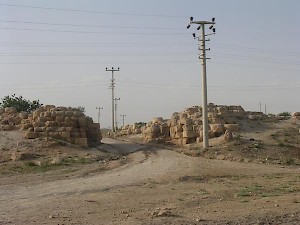
From the third millennium BCE until medieval times, Harran is mentioned as an important trade center in northern Mesopotamia, situated on the road from the Mediterranean Sea to the heart of Assyria. It is also mentioned as provincial capital in the Assyrian empire (until the late seventh century BCE) and sanctuary of the moon god Sin, well into the third century CE. This sanctuary was called Ehulhul, and was restored by Assyrian rulers like of Šalmaneser (r.858-824) and Aššurbanipal (r.668-631).
Other gods venerated in Harran were Sin's consort Ningal, the Syrian goddess Atargatis and the Arab goddess Allat ("Mrs. God"). In the Bible, it is mentioned as one of the towns where Abraham stayed on his voyage from Ur to the promised land.note The well where a servant of Abraham met Rebecca, who was to become the wife of Isaac,note is still shown today.
The End of Assyria
Although the town is mentioned as early as 2000 BCE, the city became famous at the end of the seventh century, when the Babylonian king Nabopolassar defeated an Assyrian force on the banks of the Euphrates, south of Harran (25 July 616). In these years, the Assyrian empire was disintegrating, and the Babylonians and the Median leader Cyaxares were unitedly attacking the ancient empire. In 614, they captured Aššur, and two years later, Nineveh was destroyed. The end of the two Assyrian capitals, however, was not the end of the war, however. A new king, Aššur-uballit, set up a kingdom in Harran and defied the Babylonians.
But he was no match for Nabopolassar, who, according to the Fall of Nineveh Chronicle, "marched to Assyria victoriously" in the fifteenth and sixteenth year of his reign (612-609). Aššur-uballit was forced to leave Harran, but convinced the Egyptians that they had to support his hopeless cause. A large army under command of pharaoh Necho II (r.610-595) advanced to the north. In June 609, Necho and Aššur-uballit tried to recapture Harran and they close to victory, but they had to lift their siege of Harran in August. This was the end of Assyria, its last capital now being part of the Babylonian empire. Harran was now in an area controled by the Medes.
Babylonian Age
The first half of the sixth century, Babylon was ruled by king Nebuchadnezzar (r.605-562). This was the age of Babylonian glory and splendor, and Harran appears to have benefitted as well. The Bible mentions merchants from Harran.note However, not everything was fine, and in 555 a coup d'état took place, which led to the accession of king Nabonidus, an old man, who may in fact have been nothing more than a puppet for the real ruler, his son Belsassar.
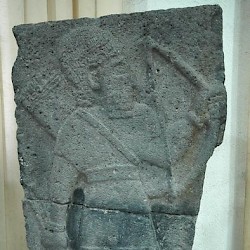 Harrian, Relief of an archaic warrior |
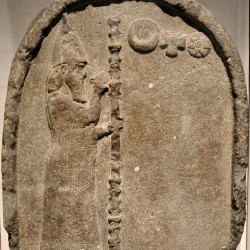 Harran, Relief of Nabonidus |
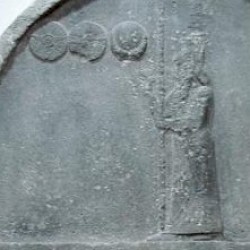 Harran, Relief of Nabonidus |
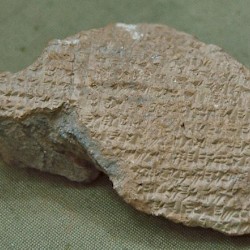 Harran, Cuneiform tablet |
Nabonidus shocked the religious authorities of Babylon by his dedication to Sin of Harran. A Babylonian king was expected to venerate the supreme god Marduk and take part in the Akitu festival. Nabonidus would have none of it. Instead, he left Babylon and started to live in the Arabian Desert (more...). At the same time, he rebuilt the temple of Sin at Harran, Ehulhul. Meanwhile, the Babylonians felt betrayed and started to sympathize with king Cyrus of Persia, who had already defeated the Medes and Lydians. When he announced to restore the cult of Marduk, the Babylonians sided with him (October 539).
Hellenistic Age
Harran was now part of the Achaemenid Empire, which was replaced two centuries later by that of the Macedonian king Alexander the Great. The conqueror may have visited Harran in the late summer of 331. After Alexander's death in 323, Harran was part of the empire of the Seleucids, the Macedonian dynasty ruling in Asia. They settled Macedonian veterans at Harran, which remained a recognizable entity after the Seleucid empire had been replaced by that of the Parthians.
In 53 BCE, the Roman general Crassus invaded Parthia. The descendants of the Macedonians sided with him, but nonetheless, he was defeated by a Parthian commander who is called Surena in the Greek and Latin sources, and must have been a member of the Parthian Sûrên clan. The battle of Harran - or Carrhae as the Romans called it - was the beginning of a series of border wars that were to last for centuries.
Roman Age
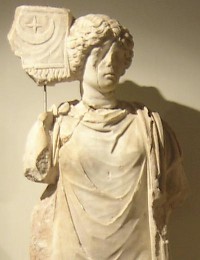
In this period, Harran belonged to a small kingdom called Osrhoene, which was part of the larger Parthian empire and had nearby Edessa as its capital. The Roman emperor Lucius Verus (r.161-169) tried to conquer this kingdom and nearby Nisibis and was successful, but an epidemic broke out and made annexation impossible. However, a victory monument was erected in Ephesus, and Harran is shown as one of the subject towns. The Roman emperor Septimius Severus finally added Osrhoene to his realms in 195. The conic domed houses of ancient Harran, which have remained unchanged until the present day, can be seen on the Arch of Septimius Severus on the Forum Romanum.
His successor Caracalla gave Harran the status of colonia (214) and visited the city in April 217, because he wanted to visit the temple of Sin. Instead, he was murdered by the prefect of the Praetorian guard, Macrinus, who was to be the new emperor.
The Roman emperor Julianus Apostata sacrificed to Sin in 363, at the beginning of his ill-fated campaign against the Sasanian Persians. From now on, the region was a battle zone between the Romans and Sasanians. It remained Roman (or Byzantine) until 639, when the city was captured by the Muslim armies.
Late Antiquity
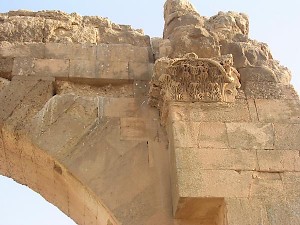
At that time, the cult of Sin still existed. Another late-antique religion of Harran was Sabianism. Its adherents worshipped Sin, Mars, and Shamal, the lord of the spirits. Women and men had equal rights, and everyone lived ascetic, refraining from several kinds of meat and groceries. After the arrival of the Islam, they probably went to live in the marshes of the lower Tigris and Euphrates, and are still known as Mandaeans.
The ancient city walls surrounding Harran, 4 kilometer long and 3 kilometer wide, have been repaired throughout the ages (a.o. by the Byzantine emperor Justinian in the sixth century), and large parts are still standing. The position of no less than 187 towers has been identified. Of the six gates (Aleppo gate, Anatolian, Arslanli, Mosul, Baghdad, and Rakka gate), only the first one has remained.
The site of Ehulhul, the ancient temple of Sin, has been used as a castle; its ruin can still be visited, but there are no traces of the shrine itself. Nor are there many ancient remains, although elements of ancient buildings have been reused in, for example, the late Umayyad "Paradise Mosque". The typical, conical houses of Harran that we see on the Arch of Septimius Severus in Rome, still exist.
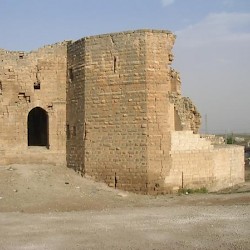 Harran, Ayyubid castle |
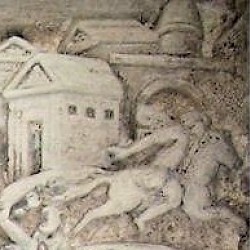 Harran on the Arch of Septimius Severus |
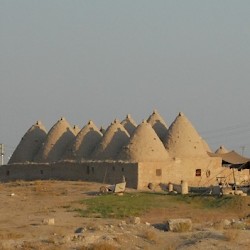 A modern house in Harran |
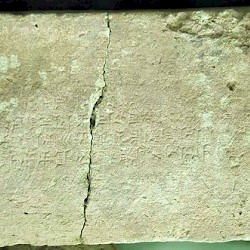 Harran, Cuneiform brick |